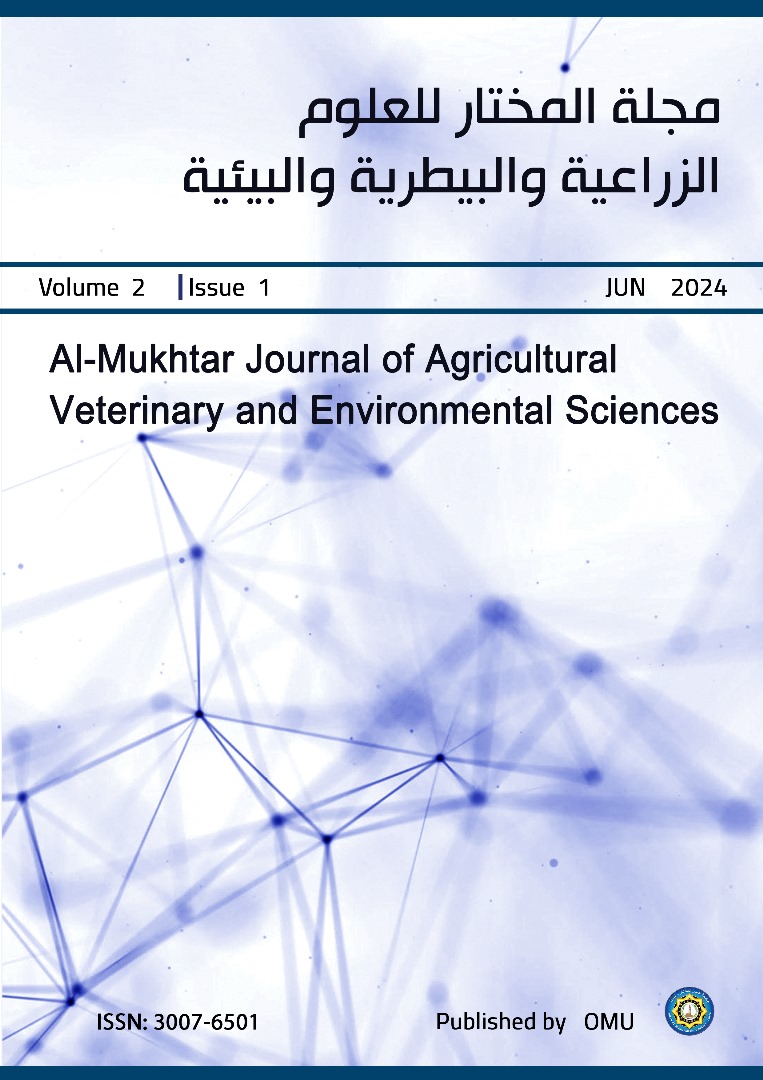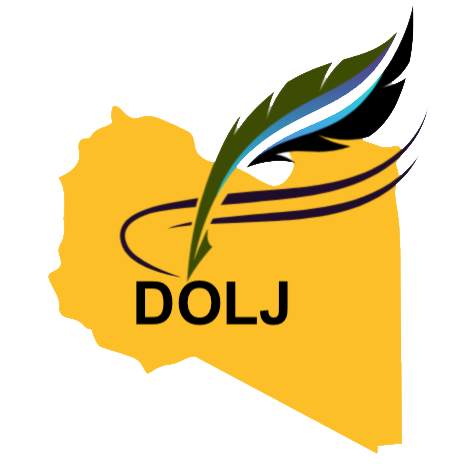قائمة الثروة الحيوانية في منطقة الابيار (زازة- جيرة - تاكنس) برقة - ليبيا
DOI:
https://doi.org/10.54172/n5qjjy37الكلمات المفتاحية:
قائمة الحيوانات البرية، برقة، ليبياالملخص
تكشف القائمة المرجعية لمنطقة الدراسة، التي تم إعدادها بدقة من خلال مزج الدراسات السابقة من المراجع، والزيارات الميدانية والملاحظات المباشرة للمؤلفين، وملاحظات المجتمعات المحلية، عن 36 نوعًا تمثل 29 عائلة. وتتناول القائمة المرجعية توزيعهم الجغرافي، وتسجل تواجدها في منطقة الدراسة. تتيح لنا هذه الصورة الشاملة فهم العلاقة الدقيقة بين كل نوع البيئات التي تعيش فيها. ومع ذلك، يلعب النشاط البشري دورًا حاسمًا في تشكيل التوزيع والكثافة الانواع للحيوانات في المنطقة. إنه بمثابة تذكير قوي بالحاجة الملحة لجهود الحفظ التنوع الحيوي البري في برقه. تضع القائمة المرجعية الأساس لتحديد وحماية الموائل الحيوية والأنواع المهددة بالانقراض، مما يضمن استمرار صدى سيمفونية الحياة في هذا الركن من العالم للأجيال القادمة.
المراجع
Agency, C. I. (2004). World factbook: Central Intelligence Agency.
Al-Awami, A. (1973). Wild Vertebrate Animals In The Libyan Arab Republic, (1st ed.). Tripoli,Libya: Dar AL-Fikr Library,pp.23_24.(In Arabic).
Alaib, M., El-Sherif, I., & Al-Hamedi, R. (2017). Floristic and ecological investigation of Wadi Al—Agar in Al—Jabal Al—Akhdar—Libya. Libyan Journal of Science.Technology 5(1).
Antonelli, A., Smith, R. J., Perrigo, A. L., Crottini, A., Hackel, J., Testo, W., Andermann, T. (2022). Madagascar’s extraordinary biodiversity: Evolution, distribution, and use. Science, 378(6623), eabf0869.
Bauer, A. (1993). African-South American relationships: a perspective from the Reptilia. Biological relationships between Africa South America 244-288.
Bauer, A. M., DeBoer, J. C., & Taylor, D. J. (2017). Atlas of the Reptiles of Libya. Proc. Cal. Acad. Sci, 64(8), 155-318.
Brotons, L., Thuiller, W., Araújo, M. B., & Hirzel, A. H. (2004). Presence‐absence versus presence‐only modelling methods for predicting bird habitat suitability. Ecography, 27(4), 437-448.
Bsisa, H. A., Fadil.M,and Basbhir,T.,. (2019). the Libyan journal of science, 22, 27 44.
Caughley, G. (1994). Directions in conservation biology. Journal of animal ecology, 215-244.
Ceballos, G., Ehrlich, P. R., & Dirzo, R. (2017). Biological annihilation via the ongoing sixth mass extinction signaled by vertebrate population losses and declines. Proceedings of the national academy of sciences, 114(30), E6089-E6096.
Cooney, R. (2004). The precautionary principle in biodiversity conservation and natural resource management: an issues paper for policy-makers, researchers and practitioners: IUCN.
dos Anjos, L., Collins, C. D., Holt, R. D., Volpato, G. H., Mendonça, L. B., Lopes, E. V., . . . Carvalho, J. (2011). Bird species abundance–occupancy patterns and sensitivity to forest fragmentation: implications for conservation in the Brazilian Atlantic forest. Biological conservation, 144(9), 2213-2222.
Dougrameji, J. (1975). Arab Centre for the Studies of Arid Zones and Dry Lands (ACSAD), Damascus, Syria. activities of the Soil--Water Division. Soils Bull Food Agric Organ UN.
El Harer, H. S. (2014). Extinction and its impact on wild animal diversity in Libya, The Seventh International Conference on Development and Environment in the Arab World,. Center for Environmental Studies and Research - Assiut University - Egypt (research paper) (in Arabic).23_25
Elkahwage, I. E., & Jdeidi, T. B. (2018). Survey of the wild mammalian species in Misallatah Nature Reserve and National Park (MNRNP). Attie Memorie Dell’ente Fauna Siciliana, 12, 101-112.
Fraser, L. (1844). Description of three new species of birds. Paper presented at the Proc. Zool. Soc. London.
Ghigi, A. (1913). Materiali per lo studio della fauna libica. Memorie Reale Accademia delle Scienze di Bologna, 10, 253-296.
Gippoliti, S., Amori, G., Castiglia, R., Colangelo, P., & Capanna, E. (2014). The relevance of Italian museum collections for research and conservation: the case of mammals. Rendiconti Lincei, 25, 351-357.
Herrmann, H., Babbitt, K. J., Baber, M. J., & Congalton, R. G. (2005). Effects of landscape characteristics on amphibian distribution in a forest-dominated landscape. Biological conservation, 123(2), 139-149.
Hoffmann, M., Hilton-Taylor, C., Angulo, A., Böhm, M., Brooks, T. M., Butchart, S. H., . . . Cox, N. A. (2010). The impact of conservation on the status of the world’s vertebrates. Science, 330(6010), 1503-1509.
Maiorano, L., Falcucci, A., & Boitani, L. (2006). Gap analysis of terrestrial vertebrates in Italy: priorities for conservation planning in a human dominated landscape. Biological conservation, 133(4), 455-473.
MoLTONI, E. (1935). a-Uccelli inanellati. Riv. It. Ornit, 5, 116-117.
Nelson, H. D. (1979). Libya, a country study: The University.
Panel, U. N. E. P. I. R. (2011). Decoupling natural resource use and environmental impacts from economic growth: UNEP/Earthprint.
Peres, C. A., & Nascimento, H. S. (2006). Impact of game hunting by the Kayapó of south-eastern Amazonia: implications for wildlife conservation in tropical forest indigenous reserves. Human exploitation biodiversity conservation 287-313.
Ripple, W. J., Newsome, T. M., Wolf, C., Dirzo, R., Everatt, K. T., Galetti, M., Lindsey, P. A. (2015). Collapse of the world’s largest herbivores. Sci. Adv. 1, e1400103. In.
Rosendal, K., & Schei, P. J. (2012). Convention on Biological Diversity: from national conservation to global responsibility. In International Environmental Agreements (pp. 119-132): Routledge.
Salvadori, T. (1922). Missione zoologica del Dott. E. Festa in Cirenaica: I.-Uccelli. Bollettino dei Musei di Zoologia ed Anatomia comparata della R. Università di Torino 36(738), 318-352.
Schipper, J., Chanson, J. S., Chiozza, F., Cox, N. A., Hoffmann, M., Katariya, V., . . . Temple, H. J. (2008). The status of the world's land and marine mammals: diversity, threat, and knowledge. Science 322(5899), 225-230.
Scortecci, G. (1934). Ofidi velenosi della Somalia italiana: Istituto poligrafico dello Stato.
Scortecci, G. (1935). Relazione preliminare delle ricerche zoologiche eseguite nel Fezzàn per conto della Reale Società Geografica. Bollettino della Società Geografica Italiana, 279-291.
Stokes, K., Broderick, A., Canbolat, A., Candan, O., Fuller, W., Glen, F., Distributions. (2015). Migratory corridors and foraging hotspots: critical habitats identified for Mediterranean green turtles. Diversity, 21(6), 665-674.
Vié, J.-C., Hilton-Taylor, C., & Stuart, S. N. (2009). Wildlife in a changing world: an analysis of the 2008 IUCN Red List of threatened species: IUCN.
Wilson, D. E., & Reeder, D. M. (2005). Mammal species of the world: a taxonomic and geographic reference (Vol. 1): JHU press.
Wudl, F., Wobschall, D., & Hufnagel, E. J. (1972). Electrical conductivity by the bis (1, 3-dithiole)-bis (1, 3-dithiolium) system. Journal of the American Chemical Society 94(2), 670-672.
Zavattari, E. (1937). Ricerche faunistiche in Africa Orientale. Italian Journal of Zoology 8(1), 247-253.
التنزيلات
منشور
إصدار
القسم
الرخصة
الحقوق الفكرية (c) 2024 Aqeelah B. Al-abdly, Abdulghani A. Abdulghani, Yacoub M. El-Barasi, Husayn A. Mohammed, Mohsen. Chammem (Author)

هذا العمل مرخص بموجب Creative Commons Attribution-NonCommercial 4.0 International License.













